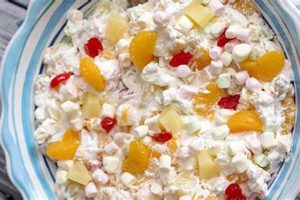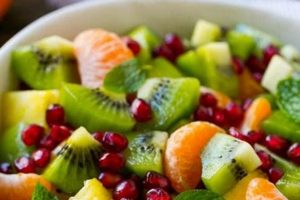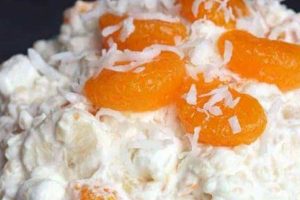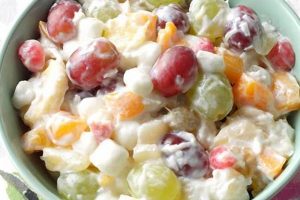A refreshing and popular dish, particularly in the Philippines, this culinary creation typically combines young coconut (buko) with a medley of other fruits, often including ripe mango, papaya, pineapple, and banana. Sweetened cream or milk, and sometimes other ingredients like nata de coco or kaong, are added to create a rich, textured dessert or snack. Variations exist, with some recipes incorporating condensed milk for added sweetness or fruit cocktails in syrup for convenience.
This dish offers a delightful balance of flavors and textures, contrasting the creamy sweetness of the coconut with the tartness and juiciness of the other fruits. Its light and refreshing nature makes it ideal for warm climates and festive occasions. Furthermore, its utilization of readily available tropical fruits contributes to its popularity and accessibility in regions where these ingredients thrive. It represents a vibrant culinary tradition, reflecting the agricultural bounty and cultural preferences of specific geographic locations.
The following sections will delve into specific aspects of creating this delightful dish, encompassing ingredient selection, preparation techniques, variations, and serving suggestions. From choosing the perfect young coconut to achieving the desired balance of sweetness and acidity, a comprehensive guide will be provided for both novice and experienced cooks.
Tips for a Perfect Buko Fruit Salad
Achieving a harmonious blend of flavors and textures requires careful consideration of several factors. The following tips offer guidance for creating a truly exceptional fruit salad.
Tip 1: Selecting the Buko: Opt for young coconuts with ample, tender meat and plenty of sweet water. Avoid those with cracked or damaged husks, which may indicate spoilage.
Tip 2: Fruit Ripeness: Use ripe, but not overripe, fruits for optimal flavor and texture. Slightly underripe fruits can provide a pleasant tartness, while overripe fruits may become mushy.
Tip 3: Balancing Sweetness: Adjust the sweetness level based on the sweetness of the chosen fruits. Less ripe fruits may require additional sweetener, while very ripe fruits may need less.
Tip 4: Enhancing Creaminess: Heavy cream, condensed milk, or all-purpose cream can be utilized to enhance the creaminess and richness of the salad. Coconut milk adds a complementary tropical flavor.
Tip 5: Adding Texture: Incorporating elements like nata de coco, kaong, or even small tapioca pearls provides textural contrast and visual appeal.
Tip 6: Chilling Time: Allowing the salad to chill for at least 30 minutes before serving enhances the flavors and allows them to meld together harmoniously.
Tip 7: Presentation: Serve the fruit salad in chilled bowls or glasses. Garnishing with fresh mint leaves or toasted coconut flakes elevates the visual presentation.
By following these tips, one can ensure a delightful culinary experience, maximizing the flavors and textures of this tropical fruit salad.
The provided guidance offers a pathway to creating a truly memorable dish. The concluding section will offer further inspiration and suggestions for variations and customization.
1. Fresh, Young Buko
Fresh, young buko forms the cornerstone of a successful buko fruit salad recipe. Its unique flavor profile and textural qualities significantly influence the overall sensory experience. The tender, almost jelly-like consistency of young coconut meat contrasts delightfully with the firmer textures of other fruits typically included in the salad, such as mango or papaya. Furthermore, the subtly sweet and slightly nutty flavor of young buko provides a nuanced base that complements the sweetness and acidity of other fruits, preventing the salad from becoming overly sugary. Using mature coconut meat would result in a significantly different, and often less desirable, texture and taste. The firmness of mature coconut, while suitable for other applications, lacks the delicate tenderness essential for this specific fruit salad. Its more pronounced coconut flavor can also overpower the other fruit flavors.
The importance of fresh buko is further exemplified in the traditional Filipino preparation of this dish. Often, the young coconut is opened and the water reserved to be incorporated into the sweet dressing or served as a refreshing beverage alongside the salad. This practice highlights the resourcefulness and appreciation for the entirety of the young coconut. Beyond its textural and flavor contributions, fresh buko offers a visual appeal. Its pristine white color creates a vibrant contrast against the colorful backdrop of other fruits, enhancing the overall presentation. Attempting to substitute with canned or processed coconut often results in a compromised texture, a less vibrant appearance, and a diminished overall quality.
Selecting and utilizing fresh, young buko represents a critical step in creating an authentic and enjoyable buko fruit salad. Its inherent qualities, from texture and flavor to visual appeal, contribute significantly to the dish’s overall success. Understanding the crucial role of this primary ingredient allows for informed choices and ultimately, a more rewarding culinary experience. While variations exist, the emphasis on fresh, young buko remains a constant for achieving the desired flavor profile and textural complexity that defines this classic dish.
2. Ripe, Varied Fruits
The inclusion of ripe, varied fruits is essential to a successful buko fruit salad recipe. Beyond mere additions, these fruits contribute significantly to the overall flavor profile, texture, and visual appeal of the dish. The careful selection and balance of these components elevate the salad from a simple mix of ingredients to a harmonious culinary experience. The following facets explore the key aspects of this crucial element.
- Flavor Complexity:
Different fruits contribute unique flavor notes, creating a complex and balanced profile. The sweetness of ripe mangoes complements the tartness of pineapple, while the subtle sweetness of papaya adds another dimension. This interplay prevents the salad from becoming monotonous and offers a dynamic sensory experience. Consider, for example, the contrasting flavors of a sweet Philippine mango versus the slight tang of a ripe guava. Their combination within the salad adds depth and intrigue.
- Textural Contrast:
Varied fruits introduce a range of textures, enhancing the overall mouthfeel. The soft, yielding texture of ripe bananas contrasts with the firmer bite of apples or the juicy burst of grapes. This interplay of textures adds a delightful complexity, making each bite an exploration of different sensations. Including fruits like jackfruit or rambutan further exemplifies this textural diversity.
- Visual Appeal:
The vibrant colors of various fruits contribute to the visual appeal, making the salad more enticing. The bright yellow of mangoes, the deep red of strawberries, and the vibrant orange of papaya create a visually stunning presentation. This visual element enhances the dining experience, making the salad as appealing to the eye as it is to the palate.
- Nutritional Value:
The inclusion of a variety of fruits increases the nutritional value of the salad. Different fruits offer different vitamins, minerals, and antioxidants. Combining a range of fruits ensures a broader spectrum of nutrients, contributing to a healthier and more balanced dish. This facet highlights the potential health benefits beyond the immediate sensory enjoyment.
The interplay of these facetsflavor complexity, textural contrast, visual appeal, and nutritional valuedemonstrates the significance of incorporating ripe, varied fruits in a buko fruit salad recipe. The strategic combination of these elements elevates the dish from a simple collection of ingredients to a well-rounded and satisfying culinary creation. The thoughtful selection of fruits, considering their individual characteristics and how they interact with each other and the buko base, is essential for achieving a truly exceptional fruit salad.
3. Sweetening Agent
The sweetening agent plays a crucial role in a buko fruit salad recipe, influencing the final balance of flavors and overall palatability. While the inherent sweetness of ripe fruits, especially buko, contributes significantly, an additional sweetening agent often enhances the flavor profile and compensates for variations in fruit ripeness and individual preferences. The selection and quantity of the sweetening agent are therefore key considerations. Commonly used options include:
- Condensed Milk: This popular choice provides both sweetness and creaminess, enriching the salad while binding the flavors together. Its viscosity contributes to a desirable texture, coating the fruit pieces and creating a cohesive blend. However, its intense sweetness necessitates careful portioning to avoid overpowering the delicate flavors of the other ingredients.
- Sugar: Granulated sugar, a simpler alternative, dissolves readily into the fruit juices, providing a straightforward sweetness adjustment. Its neutral flavor allows the inherent fruit flavors to shine. However, excessive use can create a grainy texture if not fully dissolved. Liquid sweeteners like simple syrup offer a smoother integration.
- Honey or Maple Syrup: These natural sweeteners offer distinct flavor profiles that can complement the tropical essence of the fruit salad. Honey imparts a subtle floral note, while maple syrup contributes a warm, caramel-like complexity. However, their stronger flavors necessitate careful balancing with the other ingredients. Their viscosity can also alter the overall texture of the salad.
The effectiveness of a chosen sweetening agent depends not only on its inherent properties but also on the characteristics of other ingredients. For instance, if using tart fruits like pineapple or green mango, a more robust sweetener like condensed milk or honey might be necessary to achieve a balanced sweetness. Conversely, using predominantly sweet fruits like ripe mangoes or bananas may require only a small amount of a milder sweetener like simple syrup or even no additional sweetener at all. Climatic conditions can also influence fruit sweetness; fruits grown in warmer climates tend to be sweeter, requiring less additional sweetening.
Balancing the sweetening agent is paramount. An insufficient amount can result in a bland and unappetizing salad, failing to highlight the vibrant flavors of the fruits. Conversely, excessive sweetness can mask the nuanced flavors, creating a cloying and unbalanced dish. Successfully navigating this balance necessitates careful consideration of the inherent sweetness of the fruits used, the type and intensity of the chosen sweetener, and individual taste preferences. Ultimately, the appropriate use of a sweetening agent elevates the buko fruit salad, creating a harmonious blend of flavors that celebrates the natural sweetness of the fruits while enhancing their individual characteristics.
4. Creamy Base
The creamy base is integral to a buko fruit salad recipe, contributing significantly to its texture, flavor, and overall appeal. This element binds the diverse fruits together, creating a cohesive and harmonious dish. Its presence transforms the salad from a simple assortment of fruits into a rich, indulgent, and satisfying dessert or snack. Understanding the function and impact of the creamy base is essential for achieving the desired sensory experience.
Several options exist for creating this creamy base, each offering unique characteristics. Heavy cream provides a rich, decadent texture and a neutral flavor that allows the fruit flavors to shine. Condensed milk adds both sweetness and creaminess, intensifying the overall richness while contributing a distinct caramel-like note. Coconut milk, a popular choice in traditional Filipino recipes, complements the buko flavor while offering a lighter, more refreshing creaminess. The choice of creamy base influences not only the flavor and texture but also the overall richness and sweetness of the salad. For instance, using heavy cream results in a less sweet, more subtly flavored salad compared to one made with condensed milk. The selection should therefore align with the desired outcome and the sweetness of the chosen fruits. Some recipes even incorporate a combination of creamy elements, blending condensed milk with heavy cream or coconut milk to achieve a specific balance of sweetness, richness, and flavor.
Beyond flavor and texture, the creamy base enhances the overall eating experience. It coats the fruit pieces, preventing them from drying out and preserving their freshness. It also creates a more luxurious mouthfeel, adding a velvety smoothness that contrasts pleasantly with the varying textures of the fruits. This textural interplay is crucial for a well-rounded sensory experience. The creamy base also contributes to the visual appeal, creating a cohesive and inviting presentation. Furthermore, the creamy base aids in distributing the sweetening agent evenly throughout the salad, ensuring a consistent flavor in each bite. Mastering the application of the creamy base, therefore, elevates the buko fruit salad, transforming it into a truly delightful culinary creation. Understanding the nuances of each option empowers informed decision-making, allowing for customization and the creation of a personalized version of this classic dish.
5. Textural Additions
Textural additions represent a crucial element within a buko fruit salad recipe, elevating the dish beyond a simple combination of flavors. These additions introduce a dynamic interplay of sensations, enhancing the overall eating experience and adding depth to the inherent qualities of the core ingredients. Understanding their role and impact is essential for crafting a well-rounded and satisfying buko fruit salad. The incorporation of textural elements creates a more engaging and memorable culinary experience.
Several ingredients commonly serve as textural additions in buko fruit salad. Nata de coco, a chewy, translucent jelly made from fermented coconut water, offers a delightful contrast to the softer textures of the fruits. Similarly, kaong, derived from sugar palm fruit, provides a firm, slightly sweet bite. Tapioca pearls, small spheres made from cassava starch, introduce a unique, slippery texture. Other options include agar-agar, grass jelly, or even small pieces of candied ginger. Each addition offers a distinct textural element, enhancing the complexity and creating a multi-sensory experience. The choice of textural additions depends on personal preference and the desired overall effect. For example, a combination of nata de coco and kaong creates a balanced interplay of chewiness and firmness, while the addition of tapioca pearls introduces a playful element. The quantity of these additions should be carefully considered to ensure a balanced texture without overwhelming the other ingredients.
The strategic use of textural additions contributes significantly to the overall enjoyment of buko fruit salad. These elements prevent the salad from becoming texturally monotonous, offering a dynamic range of sensations in each bite. They complement the existing textures of the fruits and the creamy base, creating a well-rounded and balanced profile. Beyond their textural contribution, some additions, such as nata de coco and kaong, also offer subtle flavor nuances that enhance the overall flavor profile. Furthermore, these additions can enhance the visual appeal of the salad, adding interesting shapes and colors that create a more enticing presentation. Successfully incorporating textural additions requires careful consideration of their individual properties, their interaction with the other ingredients, and the desired overall sensory experience. A well-executed balance of textures transforms the buko fruit salad from a simple refreshment into a more complex and satisfying culinary creation.
6. Chilling Duration
Chilling duration plays a crucial role in the final quality of a buko fruit salad recipe. It directly impacts the flavor profile, texture, and overall sensory experience. Sufficient chilling allows the individual flavors of the various fruits, the creamy base, and any added sweetening agents to meld and harmonize. This integration of flavors creates a more complex and balanced taste profile compared to a freshly prepared, unchilled salad. The chilling process also enhances the refreshing quality of the salad, making it particularly appealing in warm climates. A chilled salad offers a welcome contrast to ambient temperatures, providing a cooling and revitalizing sensory experience.
The impact of chilling extends beyond flavor development. Chilling firms the textures of the various fruits, creating a more pleasant mouthfeel. This effect is particularly noticeable with softer fruits like bananas and mangoes, which benefit from the chilling process by retaining their shape and preventing them from becoming overly mushy. Furthermore, chilling stabilizes the creamy base, allowing it to thicken slightly and adhere more effectively to the fruit pieces, creating a more cohesive and enjoyable texture. Without sufficient chilling, the creamy base may become watery or separate, detracting from the overall quality of the salad. Practical examples include comparing a freshly made buko fruit salad with one chilled for at least two hours. The chilled version exhibits a more pronounced and balanced flavor profile, and the textures of the fruits and creamy base are noticeably improved.
Optimal chilling duration depends on several factors, including the specific ingredients used, ambient temperature, and individual preferences. Generally, a minimum of two hours is recommended to allow sufficient flavor integration and textural enhancement. However, extending the chilling duration up to four hours or even overnight can further intensify these effects, particularly if using a creamy base that benefits from further thickening. Conversely, excessive chilling can negatively impact the salad, making the fruits too firm and potentially diminishing their delicate flavors. Finding the ideal chilling duration requires careful consideration of these factors and often involves experimentation to achieve the desired balance of flavor, texture, and temperature. Understanding the impact of chilling duration allows for informed decision-making, enabling one to optimize the final quality and enjoyment of the buko fruit salad.
7. Presentation Style
Presentation style significantly impacts the perceived value and enjoyment of a buko fruit salad recipe. While flavor and texture remain paramount, visual appeal elevates the dining experience. Consideration of presentation transforms the dish from a simple mixture into a carefully crafted culinary creation. This connection between presentation and recipe involves several key aspects. Effective presentation enhances the inherent qualities of the dish, creating a more enticing and memorable experience. The visual aspect stimulates appetite and anticipation, setting the stage for a heightened sensory experience.
Several factors contribute to effective presentation. The choice of serving vessel plays a crucial role. A clear glass bowl showcases the vibrant colors and textures of the fruit salad, while individual serving glasses or carved-out fruit shells offer a more personalized touch. Garnishing techniques further enhance visual appeal. A sprig of fresh mint, a sprinkle of toasted coconut flakes, or a drizzle of sweetened condensed milk adds a touch of elegance and reinforces the tropical theme. The arrangement of fruit pieces also contributes to the overall aesthetic. Consider arranging the fruit in a visually appealing pattern or layering different colors and textures to create depth and dimension. Thoughtful presentation extends beyond individual servings. For larger gatherings, consider presenting the salad in a hollowed-out pineapple or watermelon half for a dramatic centerpiece. These examples illustrate the practical application of presentation principles, transforming a simple dish into a visually captivating creation.
Understanding the impact of presentation style on the overall perception of a buko fruit salad recipe is crucial for maximizing its appeal. A well-presented salad enhances the perceived freshness and quality of the ingredients, creating a more positive dining experience. This attention to detail communicates care and consideration, elevating the dish beyond a simple dessert or snack. Furthermore, effective presentation can stimulate appetite and anticipation, enhancing the enjoyment of the flavors and textures. Careful consideration of visual elements, from the serving vessel to the arrangement of ingredients, transforms the buko fruit salad into a truly memorable culinary experience. This understanding allows for a more comprehensive approach to recipe development, encompassing not only flavor and texture but also the crucial element of visual appeal.
Frequently Asked Questions
This section addresses common inquiries regarding buko fruit salad preparation, offering clarity and guidance for achieving optimal results.
Question 1: Can ripe coconut be substituted for young coconut?
While mature coconut can be used, it significantly alters the dish’s intended flavor and texture. Young coconut provides a delicate sweetness and a tender, jelly-like consistency crucial for the authentic experience. Mature coconut possesses a more intense flavor and a firmer, chewier texture, which may not complement the other fruit components.
Question 2: What alternatives exist for condensed milk?
Alternatives include heavy cream or coconut cream for a similar richness and texture. Simple syrup or honey offer different flavor profiles and sweetness levels. Adjustments may be necessary based on the chosen alternative and desired sweetness.
Question 3: How long can buko fruit salad be stored?
Refrigeration is crucial for maintaining quality. Ideally, consume within two days. Exposure to air accelerates oxidation, affecting flavor and appearance. Proper storage in airtight containers minimizes this effect.
Question 4: Can canned fruits be used?
While canned fruits offer convenience, fresh fruits provide superior flavor and texture. Canned fruits often contain added sugar and preservatives, potentially altering the desired flavor balance. If using canned fruits, choose varieties packed in their own juice or water rather than heavy syrup.
Question 5: How can one prevent the salad from becoming watery?
Thoroughly drain any canned fruits before adding them to the salad. Avoid overly ripe fruits, which tend to release more liquid. Chilling the salad allows the creamy base to thicken, further minimizing wateriness.
Question 6: Can this recipe be adapted for specific dietary needs?
Adaptations for dietary restrictions are possible. Sugar substitutes or alternative sweeteners can be used for those limiting sugar intake. Dairy-free or vegan options can utilize coconut cream or other plant-based alternatives for the creamy base. Adjustments to fruit selection can cater to specific allergies or intolerances.
Careful consideration of these points ensures successful preparation and a delightful culinary experience. Understanding the nuances of ingredient selection, storage, and adaptation allows for customization and optimization based on individual needs and preferences.
The next section will provide a sample recipe, offering a practical guide for creating this refreshing and delightful dish.
Buko Fruit Salad Recipe
Exploration of this classic Filipino dish reveals a harmonious blend of culinary art and cultural significance. Emphasis on fresh, young buko underscores its foundational role, providing distinct flavor and textural complexity. Careful selection of ripe, varied fruits contributes essential sweetness, acidity, and visual appeal. The creamy base, whether condensed milk, cream, or coconut milk, binds these elements, enhancing richness and mouthfeel. Textural additions introduce another layer of sensory experience, while proper chilling allows flavors to meld harmoniously. Presentation elevates the dish, transforming it into a visually captivating culinary creation.
Mastery of this recipe extends beyond technical proficiency. It embodies an appreciation for fresh ingredients, balanced flavors, and thoughtful presentation. This understanding allows for adaptation and personalization, ensuring continued enjoyment and cultural relevance across generations. Further exploration of regional variations and innovative ingredient combinations promises continued evolution and appreciation of this refreshing and iconic dish.






